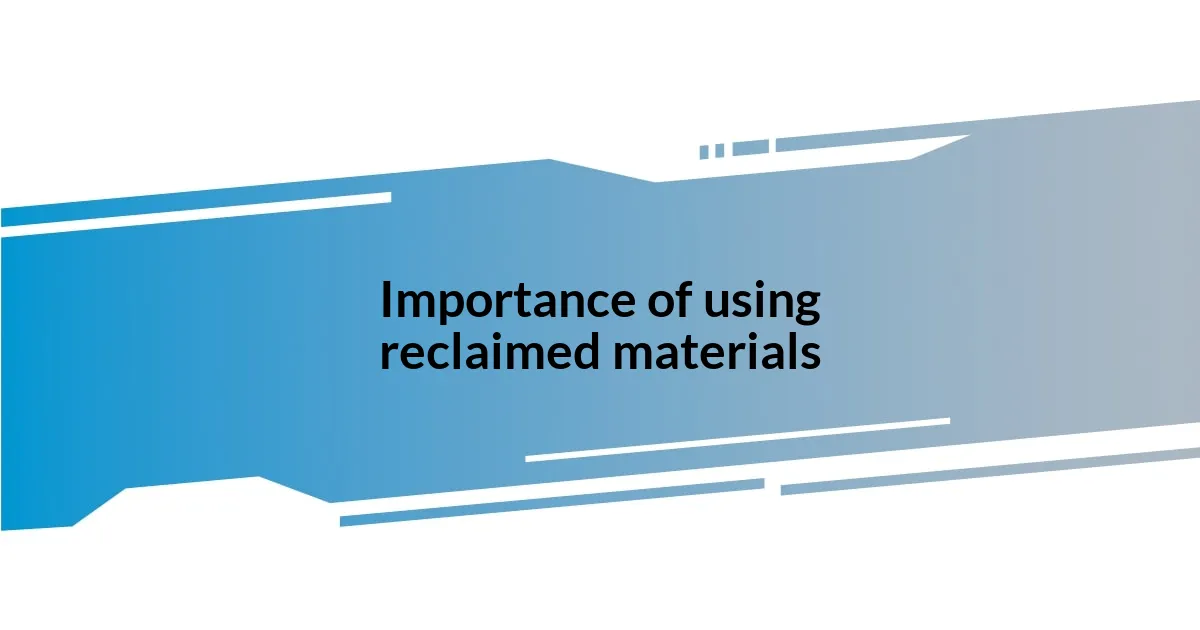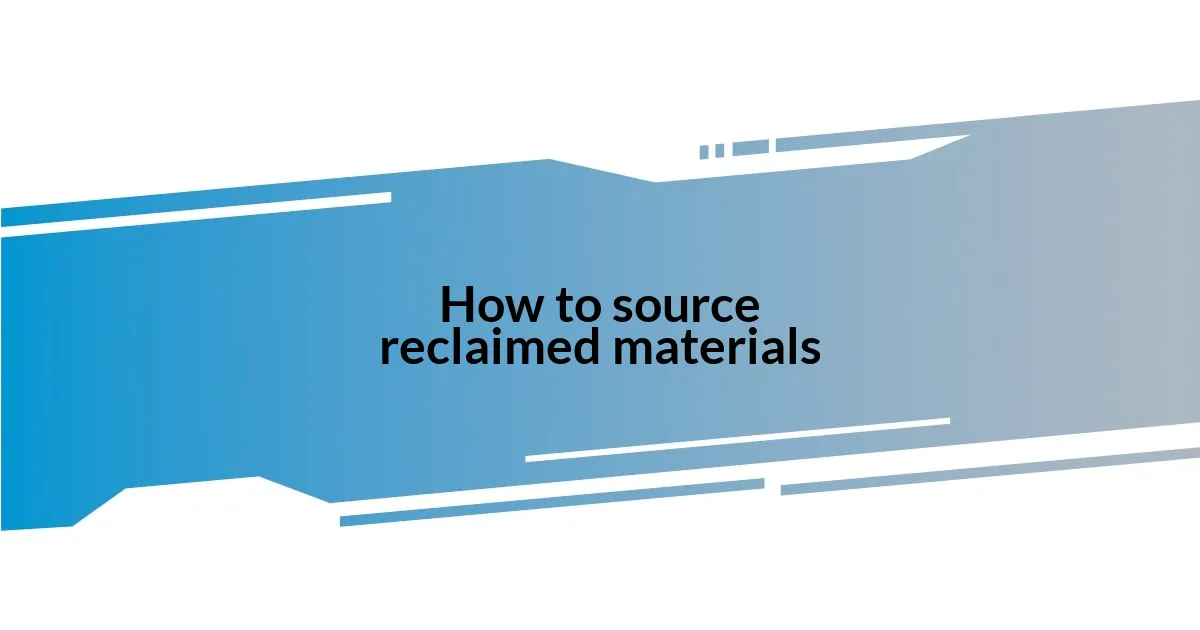Key takeaways:
- Discovering reclaimed materials ignites creativity and fosters a deeper connection to sustainability and history.
- Using reclaimed materials reduces waste, supports local economies, and encourages unique, personalized projects.
- Sourcing reclaimed materials can be done effectively through local salvage yards, online marketplaces, and community networks.
- Challenges include variability in quality, inconsistent availability, and the need for awareness of safety regulations.

My journey with reclaimed materials
I remember the first time I stumbled upon a pile of reclaimed wood at a local salvage yard. It felt like discovering hidden treasure. The thought of transforming those beaten planks into something beautiful sparked a fire in me—what stories did they carry? Each piece seemed to whisper its past, igniting my imagination and creativity.
As I began working with these materials, I found myself more mindful of the impact my choices were making. Choosing reclaimed materials wasn’t just about aesthetics; it became a way of honoring the environment and weaving sustainability into my projects. Have you ever felt that deep connection to something you’re creating? I often do, especially when I think about how every nail I used was pulled from history, repurposed instead of discarded.
One project stands out distinctly: crafting a bedside table from an old barn door. It wasn’t just about the finished product; it was the process that made it special. The joy of sanding down the imperfections, revealing the character beneath, was exhilarating. It made me wonder—how often do we overlook the beauty in things that are considered “past their prime”? Embracing reclaimed materials has completely shifted my perspective on creativity and sustainability, blending them into a beautiful, tangible journey.

Importance of using reclaimed materials
Using reclaimed materials has significant importance, both for the environment and for our creative journeys. My own experiences have taught me that these materials allow us to reduce waste and minimize our carbon footprint. I recall one winter afternoon spent sketching designs from old furniture—each piece told a story, reminding me that reusing can be just as enriching as creating from scratch.
Reclaimed materials foster a unique connection to the past and infuse projects with character. Here’s why I believe incorporating them is essential:
- Environmental Impact: Reduces landfill waste and conserves natural resources.
- Cost-effectiveness: Often more affordable than new materials, making craftsmanship accessible.
- Unique Aesthetic: Each piece carries a history, adding distinct character to any project.
- Support for Local Businesses: Purchasing from salvage yards helps sustain local economies and craftspeople.
- Encourages Creativity: The quirks of reclaimed materials can inspire innovative designs, leading to one-of-a-kind creations.
The moment I realized the impact of my choices was during a community workshop where I saw folks beam with pride over their handcrafted tables made from salvaged wood. It was clear that using reclaimed materials didn’t just transform objects—it transformed mindsets, fostering a deeper appreciation for what can be created from what once was.

Types of reclaimed materials available
The world of reclaimed materials is diverse and full of potential for creativity. When I dive into this realm, I find myself drawn to items like reclaimed wood, metal, and bricks. Each type has unique qualities that lend themselves to various projects. For example, reclaimed wood is perfect for building furniture, while salvaged metal works wonders for creating striking light fixtures. Just thinking about the possibilities makes me excited—wouldn’t you love to see how these materials can transform your space?
Another interesting category is reclaimed stone. I remember using reclaimed bricks to create a charming outdoor patio. The rich textures and colors of the bricks added a rustic charm that new materials just can’t replicate. And then there’s reclaimed glass! It’s stunning to see how old bottles can be melted down and reshaped into beautiful countertops. It makes me wonder—how often do we overlook these possibilities? Each reclaimed material has its own history and character, which can give our projects a personality that is both beautiful and meaningful.
For anyone starting to explore these materials, it’s vital to know their types and uses. Here’s a user-friendly comparison table to illustrate their characteristics better:
| Material Type | Common Uses |
|---|---|
| Reclaimed Wood | Furniture, flooring, decor |
| Reclaimed Metal | Light fixtures, furniture accents |
| Reclaimed Brick | Patios, walls, landscaping |
| Reclaimed Glass | Countertops, art pieces, windows |
Exploring these different types of reclaimed materials opens up a wealth of creative opportunities. Have you ever considered what each piece could be transformed into? It’s such a fun journey, and every choice tells a story worth sharing.

How to source reclaimed materials
When it comes to sourcing reclaimed materials, my experience has shown that local salvage yards are often hidden gems. I remember my initial visit to one, filled with a sense of adventure as I rummaged through piles of wood, metal, and countless antiques. It’s thrilling to uncover treasures that not only are affordable but also have rich histories tied to them. How often do we overlook what’s right in our own backyards?
Another effective way to source reclaimed materials is through online marketplaces. Websites dedicated to salvaged goods provide a wide array of options, allowing you to connect with sellers who share your passion for sustainability. I recall spotting a gorgeous set of reclaimed doors on one such site; they brought an air of elegance to my home renovation project. It made me think—could there be an easier route to finding those distinctive pieces that really speak to our style?
Networking with local craftsmen and attending trade shows has also become invaluable in my journey. These events often showcase recycled materials and offer excellent opportunities to chat with the creators behind them. One memorable encounter was with a woodworker who transformed old barn wood into stunning accent pieces. Through these connections, I learned how vital it is to engage with the community, as they can provide insights into sourcing specific materials. It’s like we’re all part of a bigger puzzle, where each reclaimed piece helps form a more sustainable picture.

Challenges faced with reclaimed materials
One significant challenge I faced with reclaimed materials was the variability in quality and condition. I once bought a beautiful set of reclaimed shutters, but upon closer inspection at home, I found they needed extensive repairs. It was disheartening, and I couldn’t help but wonder—can I truly trust the integrity of these materials each time? This experience taught me to approach reclaimed finds with a critical eye, allowing myself to be more discerning in my choices.
Another hurdle is the inconsistency in sourcing these materials. There are times when I’ve visited salvage yards, only to leave empty-handed, frustrated by the limited selection available. It can be emotionally taxing when you’re inspired and ready to create but faced with an uninspiring inventory. I’ve learned that patience is key; building relationships with local sellers often means getting first dibs on unique pieces. Have you considered how the thrill of the hunt can also be a part of the creative process?
Then there’s the matter of regulations and safety standards. I recall an instance where a beautifully aged wood beam caught my eye, but I later learned it contained lead paint. It was a stark reminder to research and ensure the materials I use comply with current building codes. Are the risks worth the charm of reclaimed items? Absolutely! But that sentiment comes with the responsibility to prioritize safety in our projects.